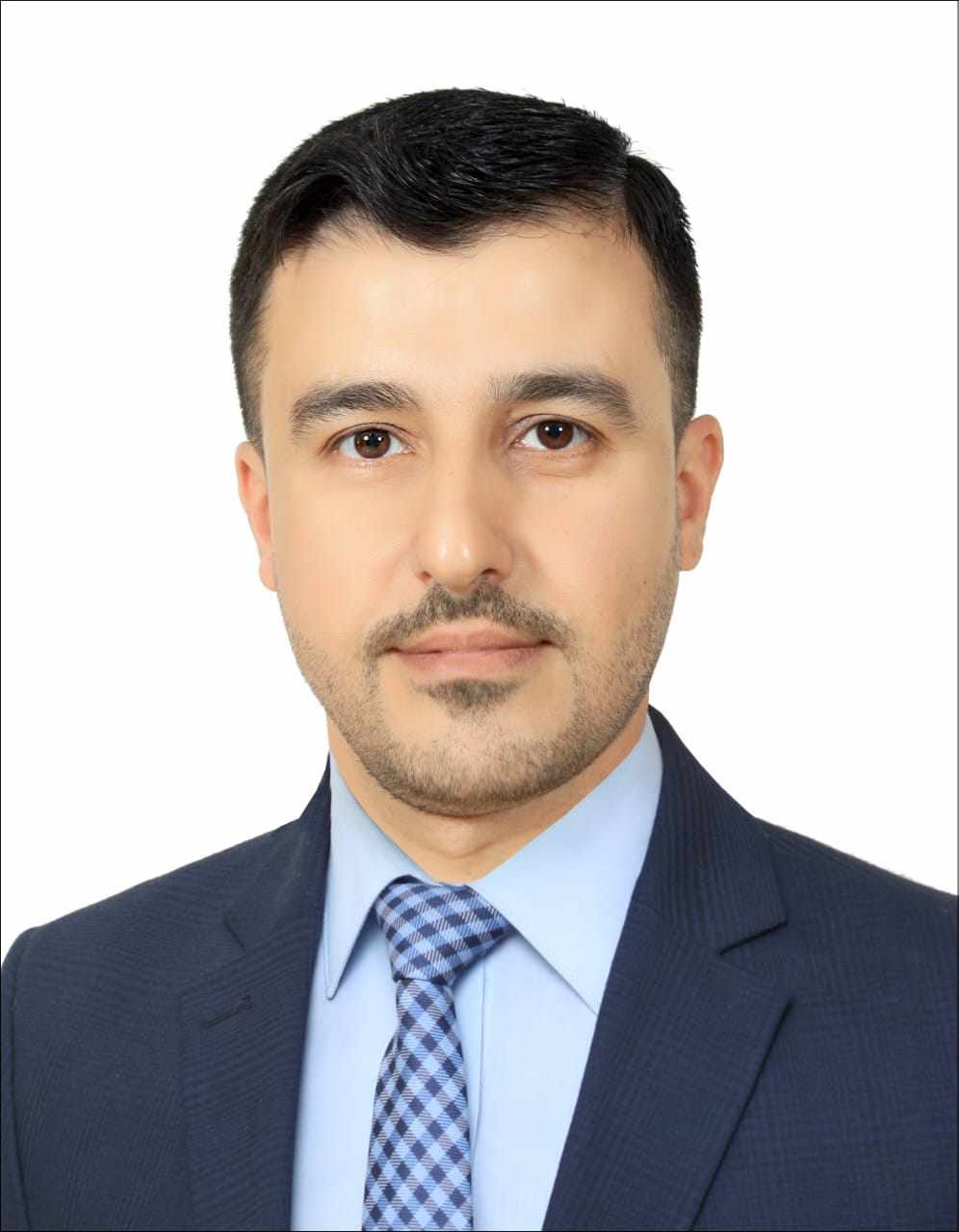
Mazin Nadheer Farhan
Research Interests|
| Gender | MALE |
|---|---|
| Place of Work | Dour Technical Institute |
| Position | Head of department |
| Qualification | Master |
| Speciality | Medical Instrumentation Engineering |
| mazin.nadheer@ntu.edu.iq | |
| Phone | 07748104407 |
| Address | Mosul, Mosul, Mosul, Iraq |
Mazin N. Farhan is an assistant professor at Northern Technical University (NTU). He earned his Bachelor's degree in Medical Instrumentation Techniques Engineering from NTU in 2007 and later obtained a Master's degree in Medical Devices from the University of Strathclyde, Glasgow, UK, in 2014.
With extensive experience in medical instrumentation, he has gained in-depth knowledge of medical devices and their operational environments. His research focuses on advancing medical technology, with primary interests in medical image processing, biosignal processing, and medical sensors. He is committed to leveraging his engineering expertise to enhance the efficiency and effectiveness of medical devices.
For academic inquiries, he can be reached at mazin.nadheer@ntu.edu.iq.
Languages
Arabic (100%)
French (30%)
English (85%)
Skills
Technical Skills (Medical Instrumentation, Medical Image Processing, Biosignal Processing, Electronic Circuits & Systems) (85%)
Research & Academic Skills (Scientific Research & Writing, Teaching & Lecturing) (90%)
Software & Tools (MATLAB, LabVIEW ) (80%)
Soft Skills (Analytical Thinking, Communication & Collaboration) (90%)
Supervision
Faris S. Azba
Year: 2024Academic Degree: Master
Supervisor Type: Co-supervisor
Supervisor State: Ungraduated
Prediction of heart failure during stress testing device based on machine learning technique
Academic Qualification
Master
Sep 1, 2013 - Sep 1, 2014Master of Science in Medical Devices With Distinction
Bachelor
Sep 1, 2003 - Jun 30, 2007Bachelor of Engineering in Medical Instrumentation Techniques
Publications
Brightness preserving enhancement for dental digital x-ray images based on entropy and histogram analysis
Sep 3, 2019Journal Journal of Applied Science and Engineering
DOI 10.6180/jase.201903_22(1).0019
Issue 1
Volume 22
Enhancing dental x-ray images could be of great importance in helping the dentist for proper diagnosis. Image enhancement by histogram equalization, log transform, gamma correction for multiple gamma values, and contrast limited adaptive histogram equalization (CLAHE) were considered. Matlab 2015 was used to perform all the enhancement tasks. Dental x-rays images (periapical images) were obtained from a dataset published on the internet. It is preferred to preserve the x-ray images brightness so that the dentist can still use it for diagnosis with gray levels as close as possible to the originals. The CLAHE image enhancement, with eight rows and eight columns with clip limit of 0.01, proves to be the best. Two metrics were used for deciding the best enhancement, the entropy, looking for the highest obtained entropy, and the flatness of the resulted histogram. Eye inspection agrees with the metrics used. © 2019 Journal of Applied Science and Engineering. All rights reserved.
Streaming in-patient BPM data to the cloud with a real-time monitoring system
Dec 1, 2019Journal Telkomnika (Telecommunication Computing Electronics and Control)
DOI 10.12928/TELKOMNIKA.v17i6.13263
Issue 6
Volume 17
Monitoring the heart activities for old people or people with medical history (Arrhythmia or CHD) is targeted by most new medical technologies. This paper demonstrated an in-patient real-time monitoring system for heart rate estimation. A ratio of beats per minute (BPM) is continuously recorded, streamed and archived to the cloud via WeMos WiFi development board. This cost effective system is simply based on two sub-systems: BPM data acquisition through pulse sensor and WeMos-based communication systems. The streamed BPM data are saved instantaneously in Google drive as spreadsheets which can only be accessed by authorized persons wherever the internet service is available. Thus, the person in charge can remotely observe the patient's status and do analytics for the archived data. A pilot study with eight subjects was carried out to validate the developed BPM tele-monitoring system. Encouraging results have been achieved.
Ultrasound Elasticity Imaging Based Multilevel Estimation Using Radiofrequency Data
Mar 20, 2020Journal IOP Conference Series: Materials Science and Engineering
DOI 10.1088/1757-899X/745/1/012105
Issue 1
Volume 745
An ultrasound elastography introduced to differentiate hard tumor inclusion embedded in soft tissue background based on similarity measurement of before and after deformation. In this study, freehand elastography has considered to localize hard inclusion embedded in soft tissue of phantom breast, where deformation generated by applying gentile compression using probe physical surface of ultrasound machine. Radiofrequency data of before and after deformation acquired and then processed off-line. A non-ability of refinement operation to regularize displacement estimation outliers at correlation window length of 2λ is addressed, where a multilevel processing algorithm has proposed to reinforce refinement operation by producing smooth elastography. In the first level of the processing, displacement field has estimated at correlation window length of 3λ, where global stretching as re-correlation operation and refinement operation as spatial regulation are included. While at second level, production of displacement estimation outliers at correlation window length of 2λ are regularized based on replacement of estimated cells with that interpolated one at first level. Results show an ability of multilevel algorithm to cope the issues that encountered previously proposed algorithm of refinement on estimation outlier free displacement field at an axial resolution of 2λ, and produces differential strain field. © 2020 IOP Publishing Ltd.
Qualitative assessment of image enhancement algorithms for mammograms based on minimum EDV
Apr 1, 2020Journal Telkomnika (Telecommunication Computing Electronics and Control)
DOI 10.12928/TELKOMNIKA.V18I2.14085
Issue 2
Volume 18
Breast cancer is one of the leading reason of death among women. Nevertheless, medications for this fatal disease are still away of ambitions. Patients (thought to have breast cancer) should go through several advanced medical diagnostic procedures like mammography, biopsy analysis, ultrasound imaging, etc. Mammography is one of the medical imaging techniques used for detecting breast cancer. However, its resulted images may not be clear enough or helpful for physician to diagnose each case correctly. This fact has pushed researchers towards developing effective ways to enhance images throughout using various enhancement algorithms. In this paper, a comparison amongst these applied algorithms was done to evaluate the optimum enhancement technique. A morphology enhancement, which is resulted from combining top-hat operation and bottom-hat operation, was used as a proposed enhancement algorithm. The proposed enhancement algorithm was compared to three other well-known enhancement algorithms, specifically histogram equalization, logarithmic transform, and gamma correction with different gamma values. Twenty-five mammographic images were taken from the mammography image analysis society (MIAS) database samples. The minimum entropy difference value (EDV) was used as metric to evaluate the best enhancement algorithm. Results has approved that the proposed enhancement algorithm gave the best-enhanced images in comparison to the aforementioned algorithms.
Thingspeak-based respiratory rate streaming system for essential monitoring purposes
Sep 1, 2020Journal Bio-Algorithms and Med-Systems
Issue 3
Volume 16
Chronic obstructive pulmonary diseases are the most common disease worldwide. Asthma and sleep apnea are the most prevalent of pulmonary diseases. Patients with such chronic diseases require special care and continuous monitoring to avoid any respiratory deterioration. Therefore, the development of a dedicated and reliable sensor with the aid of modern technologies for measuring and monitoring respiratory parameters is very necessary nowadays. Objective: This study aims to develop a small and cost-effective respiratory rate sensor. Methods: A microcontroller and communication technology (NodeMCU) with the ThingSpeak platform is used in the proposed system to view and process the respiratory rate data every 60 s. The total current consumption of the proposed sensor is about 120 mA. Four able-bodied participants were recruited to test and validate the developed system. Results: The results show that the developed sensor and the proposed system can be used to measure and monitor the respiratory rate. Conclusions: The demonstrated system showed applicable, repeatable, and acceptable results.
Inpatient WiFi-enabled medication dispenser for improving ward-based clinical pharmacy services
Feb 1, 2023Journal Indonesian Journal of Electrical Engineering and Computer Science
Issue 2
Volume 29
Medications are vital for patients and especially for those who are receiving treatment in hospitals. Providing medications for these people is essential to maintain their health. On the other hand, medication dispensing error is one of the most common challenges that face clinical pharmacists and medical staff. These errors frequently occurred due to poor medication systems and/or human factors (i.e. environmental conditions, fatigue or staff shortage). These factors may affect prescribing, transcribing, administration, dispensing and monitoring practices which can result in disability, severe harm and even death. Avoiding medication dispensing errors is the key motivation of this paper. Consequently, a biometric-based dispensing system has been designed and implemented. The system can be installed at hospital wards and used for delivering and monitoring inpatients doses. It consists of three parts; hardware, software and mechanical part. Three 4-phase stepper motors are used for controlling the mechanical part of this system. An optical fingerprint sensor is used which is compatible with the ESP32 low-power SoC for scanning patients’ fingerprints to recognize and store their data. The system directly updates its database whenever is used by the inpatients, so that nobody can get additional doses. This system is cost-effective, reliable and easy to use. © 2023 Institute of Advanced Engineering and Science.
Human–machine interaction for motorized wheelchair based on single-channel electroencephalogram headband
Apr 1, 2023Journal Bulletin of Electrical Engineering and Informatics
Issue 2
Volume 12
Human machine interaction (HMI) allows persons to control and interact with devices. Starting from elementary apparatus which acquires input bio-signals to controlling various applications. Medical applications are amongst the very important applications of HMI. One of these medical applications is assisting fully/partially paralyzed patients to restore movements or freely move using exoskeletons or motorized wheelchairs. Helping patients with spinal cord injury or serious neurological diseases to restore their movements is a key role objective for most researchers in this field. In this paper, an EEG-based HMI system is proposed to assist patients with tetraplegia/quadriplegia to mentally control a motorized wheelchair so they can move freely and independently. EEG power spectrum (α, β, δ, θ, and γ) from the frontal lobe of brain is recorded, filtered and wirelessly sent to the wheelchair to control directions and engine status. Four different experiments were conducted using the proposed system in order to validate the performance. Two different GUIs scenarios (cross-shaped and horizontal bar) were used with the experiments. Results showed that the horizontal bar scenario considered more user friendly while the cross-shaped is the more suitable for navigation. The implemented system can be equipped with modules and sensors such as GPS, ultrasound and accelerometer that improve the system performance and reliability. © 2023, Institute of Advanced Engineering and Science.
GPS-based fall detection system for old and specially-abled people
Sep 1, 2023Journal Indonesian Journal of Electrical Engineering and Computer Science
DOI 10.11591/ijeecs.v31.i3.pp1545-1550
Issue 3
Volume 31
Falls are a serious public health concern for older people across the world. Modern telemedicine now depends heavily on remote monitoring of older patients and the ability to spot threats to human health. If a fall is not assisted in time, it can significantly reduce an older person's mobility, independence, and his/her quality of life. Older people who experience post-traumatic problems or mortality frequently do so because of falls. As a result, preventing falls consequences or providing essential help on time may depend on the early identification of falls. In this article, we propose an internet of things (IoT) based system that makes use of low-power wireless sensor networks, smart devices and cloud computing to detect falls and track positions for older and specially-abled people. The tracking is done by sending links of positions from the proposed system every 15 seconds to a specified google drive. On the other hand, an alert message will be delivered to the caregiver whenever a fall is happened. Thus, a MPU-6050 sensor and NEO-6M global positioning system (GPS) module are used with ESP32 microcontroller for the aforementioned purposes. A pilot study with several protocols was carried out to validate the cost-effective proposed system and achieved good results. © 2023 Institute of Advanced Engineering and Science.







